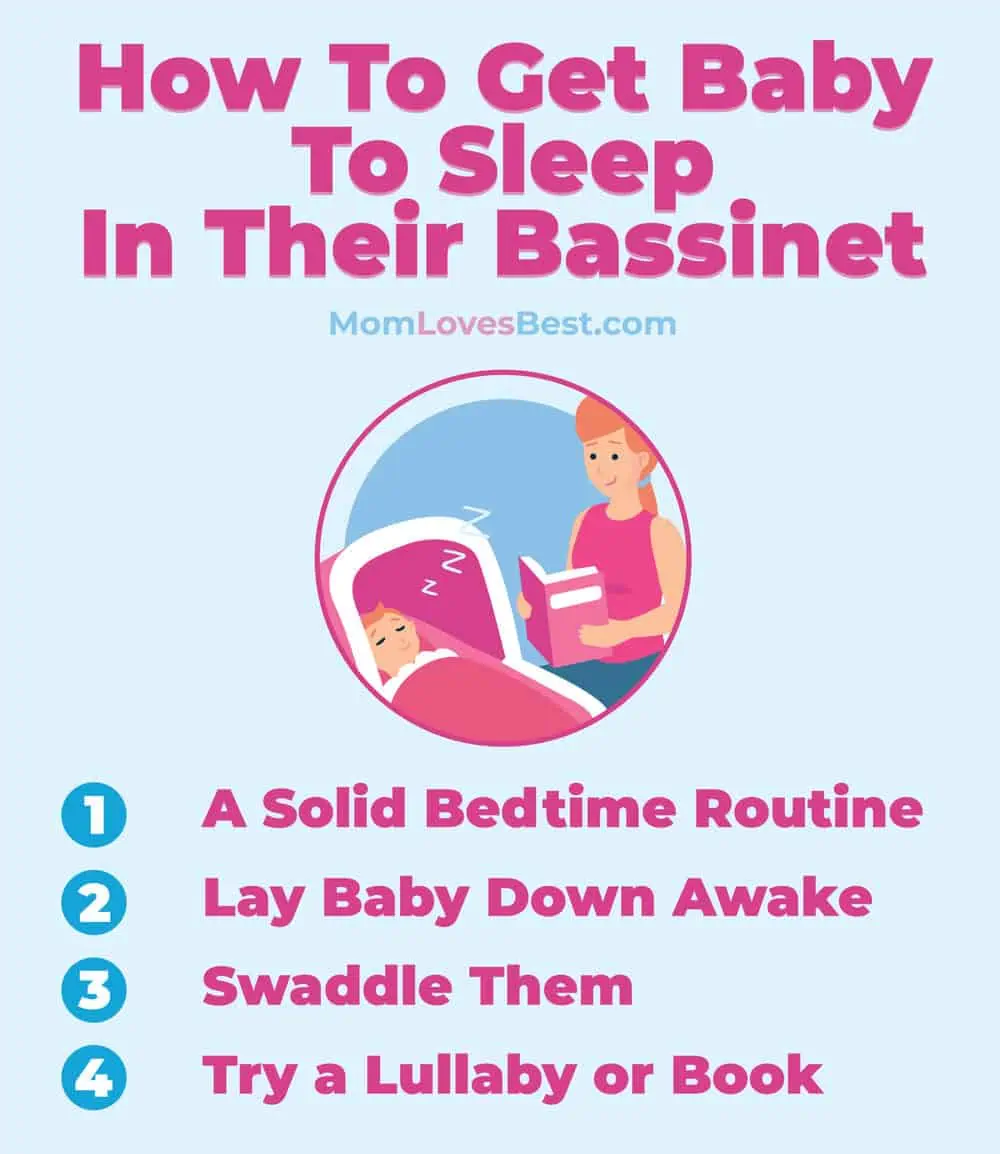Struggling to get your newborn to settle in their bassinet? You are definitely not alone.
Most babies prefer the warmth of your arms to a flat, firm mattress. However, consistent sleep in the bassinet is crucial for your rest and their safety.
We have gathered the most effective, parent-tested strategies to help your little one drift off safely in their own space.
Key Takeaways
- Build a routine: Consistent cues like bath time, massage, and low lighting signal to your baby that sleep is coming.
- Timing is everything: Aim to place your baby in the bassinet when they are drowsy but still awake to encourage self-soothing.
- Mimic the womb: Use swaddles and white noise to recreate the snug, loud environment your baby is used to.
- Prioritize safety: Always place your baby on their back on a flat, firm surface without loose blankets or positioners.
How To Get Your Baby to Sleep in Their Bassinet
You brought home the best bassinet on the market, but your little one refuses to use it. You know using it is vital for safety, yet the transition feels impossible.
If you have a stubborn sleeper, do not panic. We have compiled practical tips to help them adjust to their new sleeping space.
1. Master the Bedtime Routine
You have likely heard this advice a thousand times because it works. Implementing a steady, consistent night routine helps your baby fall asleep faster and stay asleep longer (1).
A routine does not need to be complicated. It just needs to be predictable. Start with a few simple actions to help your baby wind down:
- Bath time: Use calming bath products with lavender or chamomile.
- Massage: A light lotion massage can relax tense muscles.
- Quiet play: Dim the lights and keep voices low.
- Connection: Try reading or singing soft songs.
- Comfort: Swaddling and cuddling.
Perform these steps in the same order every night. This repetition signals to your baby’s brain that it is time to sleep, making the transition to the bassinet much smoother.
2. The “Drowsy But Awake” Technique
Cuddling is great, but rocking your baby completely to sleep can backfire. If they wake up in the bassinet and you are gone, they may panic.
The goal is to lay them down when they are drowsy but still awake. Look for heavy eyelids, yawning, or a far-off stare (2).
This is often the hardest part of sleep training, but it is essential. It teaches your baby to fall asleep independently, which eventually leads to longer stretches of sleep at night.
3. Swaddle for Security
The bassinet can feel vast and open compared to the womb. If your baby is not yet rolling over, a swaddle can bridge that gap.
Swaddling offers three major benefits:
- Security: It mimics the tight hug of the womb, helping babies relax faster.
- Reflex control: It prevents the Moro reflex (startle reflex) from waking them up when their arms flail.
- Anxiety reduction: The snugness can lower stress levels and promote deeper sleep (3).
If your baby is showing signs of rolling, you must stop swaddling immediately to prevent suffocation risks. In that case, switch to a sleep sack.
4. Pre-Warm the Bassinet
One reason babies wake up during the transfer is the temperature shock. Moving from your warm arms to a cold bassinet sheet is jarring.
Try placing a heating pad or a warm water bottle in the bassinet for a few minutes before bedtime. **Crucial:** Remove the heating device and check the surface temperature with your hand before placing your baby down. It should be comfortable, not hot.
5. Leave Your Scent
Babies have a highly developed sense of smell and find their mother’s scent soothing.
To make the bassinet feel safer, try sleeping with the bassinet sheet for a night or two before putting it on the mattress. Alternatively, parents can wear the sheet tucked into their shirt for a few hours. This transfers your scent to the bedding, reassuring your baby that you are close by.
6. Create a Womb-Like Environment
Silence is not always golden for newborns. They are used to the constant whooshing sounds of the womb.
Use a white noise machine to mask household sounds and comfort your baby (4). Combined with blackout curtains and a cool room temperature (between 68°F and 72°F), this sets the perfect stage for sleep.
Key Bassinet Safety Rules
While getting sleep is important, safety is non-negotiable. The American Academy of Pediatrics (AAP) recommends the ABCs of safe sleep: Alone, on their Back, in a Crib (or bassinet).
The safest bassinet is a bare one. Aside from a swaddle or pacifier, the sleep space must be empty. Loose blankets, pillows, bumpers, and stuffed animals all pose suffocation risks.
Avoid Sleep Positioners and Wedges
You might be tempted to use products that claim to keep your baby in a specific position or help with reflux.
- Positioners: Devices meant to keep a baby on their back are dangerous. Once a baby wiggles or rolls, they can become trapped against the device and suffocate.
- Wedges: Inclined sleep products are no longer considered safe for sleep. Babies can slide down or roll into soft sidewalls, blocking their airway.
The AAP warns against using any device that alters the slope of the bassinet mattress (5). Keep the surface flat and firm.
FAQs
The Bassinet Bottom Line
Your baby needs adequate rest to grow, and you need sleep to function as a parent. The bassinet is the safest place for that to happen.
Be patient with the process. By establishing a calming routine, using smart tools like swaddles and white noise, and practicing the “drowsy but awake” method, your little one will eventually learn to love their sleep space.











